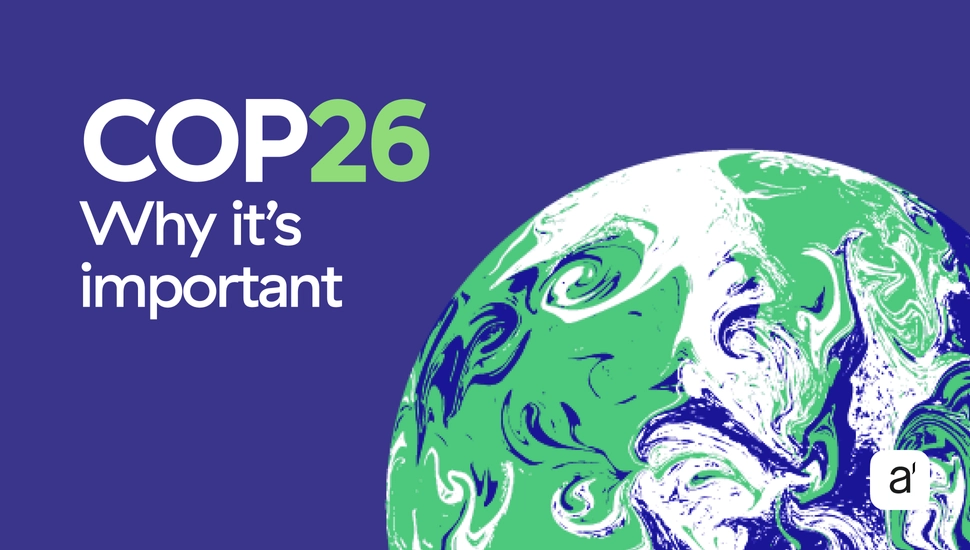For the next two weeks, the much anticipated COP26 will be hosted in Glasgow, with the UK as President in partnership with Italy. From 31st October to 12th November, 156 world leaders, along with representatives from civil society organisations and the private sector, will come together to discuss, and hopefully, take action on climate change.
The world has eyes on this conference, as its outcomes may very well determine how the next few decades will unfold in regards to climate change. In order to understand why this is such a critical moment, let’s dive into what COP26 is, its history, and its ultimate desired outcomes.
Let’s Talk Basics: What is COP26?
COP stands for Conference of the Parties – the parties in question being all signatories of the United Nation Framework Convention on Climate Change (UNFCCC), an international treaty created to combat the climate crisis through ongoing research, regular meetings, negotiations, and policy agreements.
Since 1995, the COP has been hosted in a different country annually, with the exception of last year when it was delayed due to the Covid-19 pandemic. This year marks the 26th Climate Change COP, and is being hosted by the UK in partnership with Italy. This year in particular is a crucial one as the climate crisis is on red alert. What’s different about this COP?
Context is Everything: The Paris Agreement
COPs have had a somewhat tumultuous history, marked by many historic mandates and protocols, as well as political stand-offs and standstills. Over the decades, there has never been a consensus on the urgency of climate change, the weight of responsibility upon individual nations, and the appropriate measures and policies to be taken to reduce emissions.
However, in 2015 the world witnessed a historic breakthrough: the Paris Agreement. For the first time in the three decades of meetings, almost all countries of the world came to an agreement on a common goal: to limit the rise in global warming to “well below” 2 degrees, with the ideal aim of 1.5 degrees Celsius compared to pre-industrial levels. The goals also included adapting to the impact of climate change, and mobilising finance flows to support these goals.
The Paris Agreement caused a commotion – both for its groundbreaking consensus, but also for the perceived vagueness of its aims. The questions were plentiful: are these commitments enough? How will these goals be enforced? What does “well below 2 degrees” even mean?
That’s where NDCs come in, or Nationally Determined Contributions. Countries agreed that each government is responsible for determining their target emission reductions per year, then report it to the UNFCCC.
If you suspected this wouldn’t result in the desired outcomes, you are neither alone nor wrong. Collectively, the NDCs submitted were objectively insufficient to meet the 2030 goals, and amounted to less than 1% cut in global emissions compared to 2010 levels.
The Window is Closing
As wildfires, floods and droughts devastate countries and communities around the world, there has never been a more critical time for decisive and swift action on climate change – which is why COP26 is under sharp scrutiny.
The science is now indisputable. This past August, the Intergovernmental Panel on Climate Change (IPCC) report confirmed that “human influence has warmed the atmosphere, ocean and land.” The pace and state of current environmental changes are “unprecedented by thousands, if not hundreds of thousands of years”, and many of these changes are already irreversible.
The state-of-the-science report warned that the window for action against catastrophe is closing rapidly. However, the global scientists behind the research emphasized that achieving the 1.5- degree-target was still possible – but only if sweeping, rapid actions were taken to cut global emissions. Specifically, greenhouse gas emissions must be halved by 2030, and reach ‘net-zero’ by 2050.
“Bottom line is that we have zero years left to avoid dangerous climate change, because it’s here,” Michael E. Mann, a lead author of the IPCC’s 2001 report, told CNN.
If we exceed the 1.5 degrees limit, the report warns, we will most certainly witness the effects by 2030. That means more catastrophic weather, extreme sea level events, and ultimately, devastating loss of life and livelihoods.
Keep the 1.5 Alive
This year, signatories were expected to submit much more ambitious NDCs than the ones they submitted in 2015. So far, the results have not been promising.
Of the 192 Parties of the Paris Agreement, 165 NDCs are available. When taken together, the commitments result in a 16% increase of global greenhouse gas emissions in 2030 compared to 2010. This translates to a global temperature rise of 2.7 degrees by the end of the century. Independent climate watchdog the Climate Action Tracker confirmed this in their Thursday report, which found that all G20 economies were far from enacting any effective policies to meet the 1.5 degrees goal – despite comprising 80% of the world’s emissions.
For the average reader, the difference between 1.5 and 2 degrees might seem miniscule. In fact, every increment has a monumental impact on people’s lives, communities, and ecosystems.
Alok Sharma, British MP and President of COP26, has made it clear that he is taking these warnings seriously. The overarching message of COP26 has been to “Keep the 1.5 alive” – which is to say, we need to have as many as countries as possible commit to the hard goal of – “Well below 2 degrees” can no longer be an option.
In response to the UNFCCC report, Sharma agreed that ambitious action was needed. “That is why we especially need the biggest emitters, the G20 nations, to come forward with stronger commitments if we are to keep 1.5c in reach over this critical decade. Glasgow must launch a decade of ever-increasing ambition. At COP26 we must come together for ourselves, future generations and our planet.”
COP26: What do they hope to achieve?
The COP26 has delineated several targets for this conference, which are a crucial update to the original Paris Agreement:
1. Global Net Zero by 2030
Net Zero means the amount of greenhouse gases emitted must be equal or lower than the amount removed from the atmosphere. This translates into phasing out coal completely, putting a stop to deforestation, switching to electric vehicles, and investing in renewables.
2. Adapt to Survive
The impacts of climate change are already around us – so action must be taken to adapt in order to protect communities and the environment before further damage is done. This includes stronger warning systems, more resilient infrastructure, proactive initiatives in protecting ecosystems, and more.
3. Prioritize Financial Support
Back in 2009, developed countries promised to mobilise $100 billion by 2020 to support developing countries in the fight against climate change. Governments will be pressed to fulfill this promise, alongside international financial institutions, in order for the first two goals to truly be achievable.
While news of climate change inevitably veers in the direction of pessimism and doubt, this doesn’t mean that the UNFCCC and COP26 is without hope or deep significance. As a result of these processes, we have witnessed science, media, public opinion and governments converge to create a clear discourse on the direction we need to take.
COP26 is the best mechanism we have available to enact change at the governmental and global level, and in the weeks ahead, it will be worth keeping our eyes and ears alert to what’s to come.




